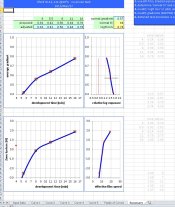- Joined
- Mar 2, 2011
- Messages
- 25
- Format
- Medium Format
Hello guys,
I want to conduct the "elaborate & precise" filmtest described in WBM 2 written by Ralph Lambrecht.
I tried the test in march, but the densities i measured were so low, that i came to the conclusion, that i had severely underexposed the Stouffer tablet trying to get a 1:1 copy of it.
Now i want to test two different films again but i am stuck at how to correctly expose the stouffer.
In march i used a bellows system on my medium format camera to get 1:1 copy of the stouffer. i taped the Stouffer to a window, relied on the average reading the built in viewfindermeter told me and exposed the films.
Result = underexposed negatives.
I then built a kind of lightbox, where i can fire a flash from behind the stouffer (which is taped to a 6x6 negative carrier) to expose it and place the camera with bellows in front of it to take a 1:1 copy of the stouffer.
My question now is how can i figure out the right exposure using the "flash method". I have go a sekonic L-358 lightmeter that can measure flashlight...do i only have to take a incident meter reading towards the flash (when the stouffer hasn't been taped to the negative carrier) and take the f-stop and time shown?!?
Logically i think that this won't work because for the actual exposure i have to tape the stouffer to the negative carrier and it will decrease the light that comes from the flash...
Which bar number on a Stouffer TP120-31 approximately equals a transmission density of medium grey?
Thank you for your help, as i am pretty confused... :-(
Best regards,
Christoph.
I want to conduct the "elaborate & precise" filmtest described in WBM 2 written by Ralph Lambrecht.
I tried the test in march, but the densities i measured were so low, that i came to the conclusion, that i had severely underexposed the Stouffer tablet trying to get a 1:1 copy of it.
Now i want to test two different films again but i am stuck at how to correctly expose the stouffer.
In march i used a bellows system on my medium format camera to get 1:1 copy of the stouffer. i taped the Stouffer to a window, relied on the average reading the built in viewfindermeter told me and exposed the films.
Result = underexposed negatives.
I then built a kind of lightbox, where i can fire a flash from behind the stouffer (which is taped to a 6x6 negative carrier) to expose it and place the camera with bellows in front of it to take a 1:1 copy of the stouffer.
My question now is how can i figure out the right exposure using the "flash method". I have go a sekonic L-358 lightmeter that can measure flashlight...do i only have to take a incident meter reading towards the flash (when the stouffer hasn't been taped to the negative carrier) and take the f-stop and time shown?!?
Logically i think that this won't work because for the actual exposure i have to tape the stouffer to the negative carrier and it will decrease the light that comes from the flash...
Which bar number on a Stouffer TP120-31 approximately equals a transmission density of medium grey?
Thank you for your help, as i am pretty confused... :-(
Best regards,
Christoph.



